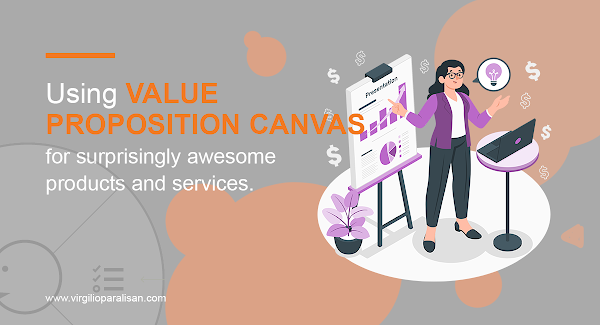Search This Blog

We help service enterprises in their growth phase with their organizational systems through focused coaching and consulting services on the following systems: leadership, communication, planning, resource management, operations, improvement & innovation, performance management, documentation, and risk management.
Featured
- Get link
- X
- Other Apps
A Right Revolutionary Idea In A Business Model Canvas
In 2016, I posted an article in LinkedIn, “Understanding Your Business through a Business Model”. I failed to introduce first the Value Proposition Canvas which is an integral part of the Business Model Canvas.Just like the Value Proposition Canvas the Business Model Canvas was developed by Dr Alexander Osterwalder.
The canvas is a visual representation of what your business is about.
The canvas is made up of the nine (9) blocks, as follows:
Customer Segment: How are your customers grouped or categorized?
Niche Market (focus on customer segment with specific and specialized requirements. A lot of car manufacturer brands rely heavily on other automobile manufacturers for their critical parts.)
Mass Market (singularly focuses on a large group of customers with broadly similar requirements and issues. This type of business model often exists in the consumer electronics industry.)
Segmented Market (a market that uses the same product or service but categorized according to slightly different needs and problems.)
Diversified Market (a market the have different customer segments being served with different products and services based on their respective needs)
Multi-sided Platform/Market (a market constituting two or more interdependent Customer Segments for example video platforms that serve video owners and at the same time serving advertisers.)
List the top three segments. You are looking for segments providing the most revenue.
Value Proposition: What currently constitutes your value proposition? What kinds of jobs do you do for your chosen customer? (Please list products and/or services you are offering your customers.)
Channels: What channels are you currently using to deliver information about your value proposition (or the product or service itself to) customers? How do you communicate with your customer? How do you deliver the value proposition?
Your own channel (store front)
Key Partners: Partner Channels (major distributors, dealers, resellers, brand ambassadors, etc.)
Combination of both
Customer Relationship: What kind of relationship are you having now and you are cultivating with your customers? How is this relationship demonstrated and how do you nurture this relationship?
Personal Assistance (A staff is always available for the customer.)
Dedicated Personal Assistance (A specific staff is assigned to a specific customer.)
Self Service (The customer is allowed to use the product or service unassisted.)
Automated Services (The customer uses the product or service through automation or website.)
Communities (The customer gets assistance from a community of customers or suppliers.)
Co-creation (The customer is involved in the design, assembly or creation of the service or product.)
Revenue Streams: What revenue streams are you getting from the customers you serve?
Typically, your revenue streams can come in the form or a combination of the following:
Asset Sale (This is the Revenue Stream you are most acquainted with. It is derived from selling ownership rights to a physical or tangible product.)
Usage Fee (This is Revenue Stream mostly generated as a consequence of customers using a particular service. The more the customer uses a service, the more your customer pays.)
Subscription (This Revenue Stream is generated by selling continuous access to a service.)
Lending/Leasing/Renting (This Revenue Stream is achieved by providing individuals or entities a temporary and exclusive right to use a particular asset within an agreed upon fixed period in return for a fee.)
Licensing (This kind of Revenue Stream is acquired by providing customers the permission to avail of the protected intellectual property in exchange for licensing fees. This allows those with intellectual property to earn revenues from their property without doing the manufacturing themselves.)
Brokerage Fees (This Revenue Stream is acquired when you act as a go-between on behalf of two or more parties.)
Advertising (This Revenue Stream is a consequence of receiving fees for advertising a particular brand, service, or product.)
A clue to finding out your revenue streams is to look at your income statement or cash flow statement and look at the sources of revenues. List your top three revenue streams. If you do things or give things for free, you can add them here too.
Key Resources: What key resources support the activities that deliver your current value proposition? These resources can come in the form of money, knowledge, means, people you need to drive the business. (Staffing, raw materials, equipment, facilities, etc.)
Key Activities: What key activities support the delivery of your current value proposition? What do you do every day to make your business model work? (Please identify critical activities that ensure your product or service is delivered to customers and are supported.)
Key Partners: Who are your key partners ensuring your value proposition can be delivered? List the partners where certain activities cannot be done or certain resources cannot be acquired without them (may not necessarily be suppliers). (These are suppliers or providers who ensure activities are completed or components of your product or service are delivered in the quality that satisfy customers.)
Cost Structure: What are the costs related to your key activities and key resources?
A clue to finding this out is to look at your income statement, and list all the major costs that allow you to operate or to deliver products or services.
List your most critical cost by looking at your operational activities and resources.
Business Model Canvas Explained (2:19)
Business Model Canvas Tutorial - Uber Business Model (6:50)
Lean Canvas Intro - Uber example (8:15)
The Business Model Canvas - 9 Steps to Creating a Successful Business Model - Startup Tips (9:41)
Business Model Canvas Explained with Examples (16:43)
Osterwalder explaining the Business Model Canvas (42:28)
If you are one of those who has learned something or anything in my post or in my coaching, please give me feedback on exactly how I actually helped you or give me a review by going to this page now!
Popular Posts
Using Value Proposition Canvas For Surprisingly Awesome Products And Services
- Get link
- X
- Other Apps
The Six Elements of Communication You Need To Exploit For Awesome Results
- Get link
- X
- Other Apps






Comments
Post a Comment